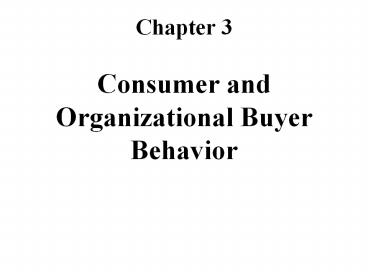Consumer and Organizational Buyer Behavior - PowerPoint PPT Presentation
Title:
Consumer and Organizational Buyer Behavior
Description:
Title: Lecture Presentation to accompany Investment Analysis & Portfolio Management, 6e Subject: Selecting Investments in a Global Market Author – PowerPoint PPT presentation
Number of Views:301
Avg rating:3.0/5.0
Title: Consumer and Organizational Buyer Behavior
1
Chapter 3
- Consumer and Organizational Buyer Behavior
2
Definitions of Consumer Behaviour
- The dynamic interaction of cognition, behaviour
and environmental events by which human beings
conduct the exchange aspects of their
lives(American Marketing Association) - A discipline dealing with how and why consumers
purchase (or dont purchase) products and
services.(Neal et al.)
3
- Difference between consumer and organizational
buying
4
Organizational buyers
- Fewer organizational buyers (10 -15
organization). - Close, long-term relationships between
organizational buyers and sellers. - Organizational buyers are more rational e.g. like
or dislike or color of the equipment's) - Organizational buying may be to specific
requirements - Organizational selling /buying may be more risky
e.g. unforeseen problems etc.
5
Organizational buyers (Cont..)
- Organizational buying is more complex
- Negotiation is often important in organizational
buying
6
Consumer Buyer Behavior
- Consumers are individuals who buy products and
services for personal consumption.
7
Consumer decision making process
8
(No Transcript)
9
Consumer decision making process
- Needs
- Information gathering
- Evaluation of alternative and selection of the
best solution - - beliefs
- - attitude
- - Intention
10
Consumer decision making process (Cont..)
- Selection of an appropriate solution (product)
- Post-purchase evaluation of decision
11
Factors affecting the consumer decision making
process
- There are number of factors that affect the
consumer decision making process and its outcome. - 1. The buying situation
- 2. Personal influence
- 3. Social influence
12
The buying situation
- Extensive problem solving
- Limited problem solving
- Automatic response
13
Personal influence
- Personal influence concerned with the psychology
of the individuals which includes personality,
motivation, perception and learning.
14
Social Influence
- Social class
- Reference group
- Culture and family
15
Organizational Buyer Behavior
- Organizational buyer behavior has usefully been
broken down into three elements - - Structure (Who)
- - Process (How)
- - Content (What)
- Structure
- - The Who factor who participates in the
decision making process and their particular
roles.
16
Organizational Buyer Behavior(Cont..)
- Process
- - The How factor- the pattern of information
getting, analysis, evaluation, and decision
making which takes place as the purchasing
organization moves towards a decision - Content
- The What factor- the choice criteria used at
different stages of the process and by different
members of the decision making unit.
17
The organizational decision making process
18
Factors affecting organizational buyer behavior
19
Buy class
- Organizational buying behavior is influenced by
the nature of the buy class. Buy class includes - Straight re-buy
- - In a straight rebuy, the purchasing department
reorders supplies such as office and bulk
chemicals on a routine basis and chooses from
suppliers on an approved list - Modified re-buy
- - The buyer in a modified rebuy wants to change
product specifications, price, delivery
requirements or other terms. - New task
- - New task purchaser buys a product or service
for the first time
20
Product Type
- Product constituents
- Materials to be used in the production process
e.g. steel, - Components to be used incorporated in the
finished product, e.g. alternator - Capital plant and equipment
- Products and services for maintenance, repair and
operation (MROs), e.g. spanners, welding
equipment and lubricants) - Product facilities (e.g. equipment's)
- MROs (e.g. spanners)
21
Importance of purchase
- Importance of purchase
- - Purchasing is the function of buying Goods
Services from external source to an
organization. Purchase department buys raw
materials, spare parts, services etc. as required
by the company or organization. ... purchase is
most important function in any organization.
22
Development in purchasing practice
- Just in time purchasing
- Just-in-time (JIT) is an strategy companies
employ to increase efficiency and decrease waste
by receiving goods only as they are needed in the
production process, thereby reducing inventory
costs. This method requires producers to forecast
demand accurately. - Centralized purchasing
- A purchasing system in which all the departments
of a company with a wide geographical
distribution can make purchases through a
common purchasing organization. Centralized
purchasing aids finding the best deals with local
vendors for the corresponding location of the
company department.
23
Development in purchasing practice (Cont..)
- System Purchasing
- System purchasing is the is the desire by buyers
to acquire completely systems rather than
individual components. - Reverse marketing
- Reverse marketing is the concept of marketing in
which the customer seeks the firm rather than
marketers seeking the customer. Usually, this is
done through traditional means of advertising,
such as television advertisements, print magazine
advertisements and online media
24
(No Transcript)
25
Development in purchasing practice (Cont..)
- Leasing
- A contract by which one party conveys land,
property, services, etc. to another for a
specified time, usually in return for a periodic
payment.
26
Relationship Management
- The supervision and maintenance of relationships
between a company and its external partners,
especially its clients.


















![Consumer Behavior [MKTG. 301] PowerPoint PPT Presentation](https://s3.amazonaws.com/images.powershow.com/4505769.th0.jpg?_=201311050410)












